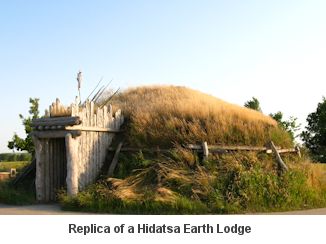Three Affiliated Tribes – Arikara, Hidatsa, and Mandan
Arikara Indians
Tribal Origin: Pawnee ConfederacyAlso known as: Sahnish, Arikaree and ReeHome Territories: North Dakato and South DakotaLanguage: CaddoanAlliances: Mandan and Hidatsas
The Arikara are a group of Caddoan-speaking American Indians who in historic times lived along the Missouri River in northern South Dakota and west-central North Dakota. The Arikara are culturally related to the Pawnee. They are believed to have originated in the Southeast and migrated north along the Missouri River before reaching the Dakotas sometime around 1770. At that time they numbered between three thousand and four thousand people.
In 1837 the Arikara were severely affected by a smallpox epidemic, and in 1862, their numbers much reduced, they joined the Mandan and Hidatsa tribes. In about 1870 all three groups were settled on the Fort Berthold Reservation in North Dakota and became known as the present day Three Affiliated Tribes. In the 1980s they numbered about one thousand.
The Arikara were primarily an agricultural people living in permanent villages of semisubterranean earth lodges located on bluffs overlooking the Missouri River. They cultivated maize, beans, squash, pumpkins, and sunflowers and also hunted bison, deer, and antelope and gathered wild foods.
Politically, the Arikara were organized into a loose Confederacy of villages led by a head chief assisted by a tribal council of village chiefs. Religious life and ceremonies centered around the planting, cultivation, and harvesting of maize, the principal food resource.
Arikara Bands, Gens & Clans
Hidatsa Indians
Tribal Origin: SiouanNative Name: Nuxbaaga, means ‘original people.’ The name “Hidatsa” is a term of their own derivation that means “willow people,” and was used by them to refer to one of their three village Subgroups. Two other subgroups were called “Awatixa” and “Awaxawi.” Home Territories: North DakotaLanguage: HidatsaAlliances: Mandan and CrowEnemies: Dakota, Cheyenne, Assiniboin, and Arikara
Aboriginally the Hidatsa occupied three villages in the Missouri River valley near the confluence of the Knife River in present-day west-central North Dakota. The Hidatsa often intermarried with their Mandan allies. Later, the remnants of the Arikara tribe joined them after a smallpox epidemic nearly wiped them out.
The Hidatsa language belongs to the Siouan language family. It is most closely related to the Crow language, which was a divergent dialect of Hidatsa. It is more distantly related to Mandan, a separate language spoken by a tribe culturally and geographically close to the Hidatsa. The Hidatsa language is still spoken today.
Mythological evidence suggests that the Hidatsa migrated into the Missouri River valley from the northeast, near Present-day Devils Lake, North Dakota. Acquiring maize agriculture from the Mandan, the Hidatsa established several Villages nearby. Archaeological evidence suggests that some Hidatsa were present in their historically known location by the early 1600s. Nearby groups included the Mandan and Crow, with whom the Hidatsa were allied, and the Dakota, Cheyenne, Assiniboin, and Arikara, all of whom the Hidatsa counted as enemies.
Sustained contact with Europeans began during the late eighteenth century, when the Hidatsa were brought into the fur trade. In 1804, the Hidatsa established peaceful relations with the United States as a result of the Lewis and Clark Expedition.
While initially prospering from the fur trade, frequent intertribal warfare with the Dakota, coupled with extensive loss of life from the 1837 smallpox epidemic, caused the Hidatsa to relocate into a single village near the relative safety of Fort Berthold in 1845. The Hidatsa were subsequently joined by the Mandan and Arikara, resulting in the formation of the Three Affiliated Tribes and the Fort Berthold Reservation during the 1860s within traditional Hidatsa territory.
Throughout the historic period, the Hidatsa have maintained peaceful relations with the United States.
Three Affiliated Tribes review new constitution
Mandan Indians
Tribal Origin: Native Name: Unlike many Indian tribes, the “Mandan,” despite various spellings, have been known by that name since the earliest contact with non-Indians. They were sometimes identified by a name belonging to one of the four divisions of Mandan—Nuitadi, Nuptadi, Awigaxa, or Istopa.Home Territories: MissouriLanguage: SiouanAlliances: Hidatsa, Assiniboine, Cree, Arikara, and CrowEnemies: Cheyenne, Yanktonai, and Lakota (Teton) were sometimes peaceful, sometimes unfriendly.
In early historic times, the Mandan lived along the Heart River, a major tributary of the Missouri, in western North Dakota. In 1804, Lewis and Clark found they had moved north and settled on the Knife River. Today, they live in the southern segment of Fort Berthold Indian Reservation, about one hundred miles northwest of their original location.
